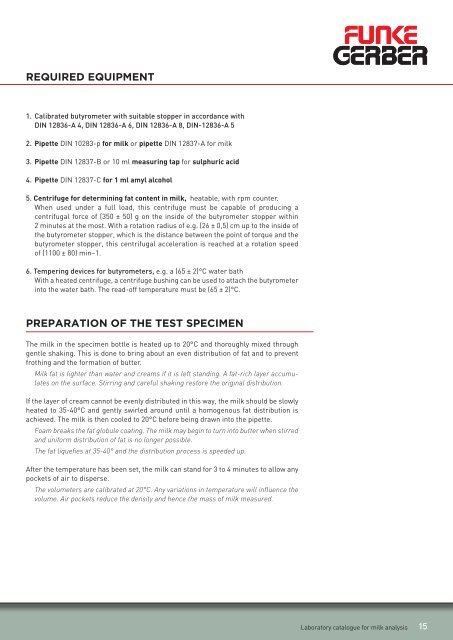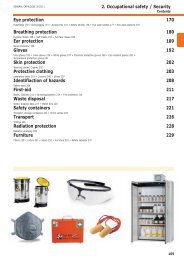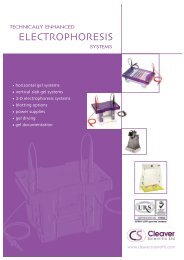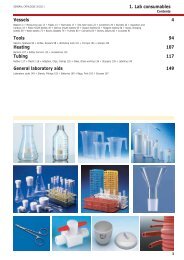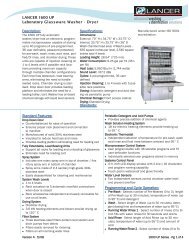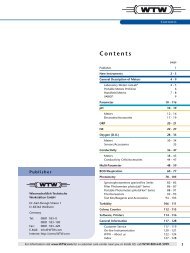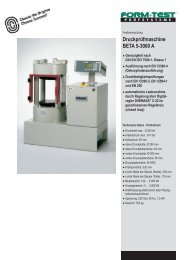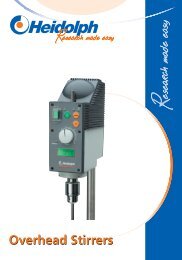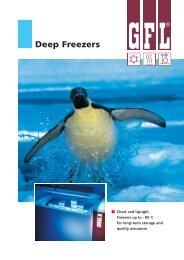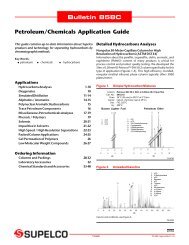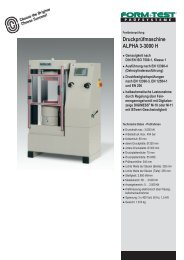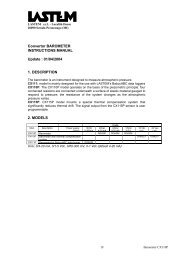LABORATORY CATALOGUE for milk analysis - Labochema
LABORATORY CATALOGUE for milk analysis - Labochema
LABORATORY CATALOGUE for milk analysis - Labochema
You also want an ePaper? Increase the reach of your titles
YUMPU automatically turns print PDFs into web optimized ePapers that Google loves.
Required equipment<br />
1. Calibrated butyrometer with suitable stopper in accordance with<br />
DIN 12836-A 4, DIN 12836-A 6, DIN 12836-A 8, DIN-12836-A 5<br />
2. Pipette DIN 10283-p <strong>for</strong> <strong>milk</strong> or pipette DIN 12837-A <strong>for</strong> <strong>milk</strong><br />
3. Pipette DIN 12837-B or 10 ml measuring tap <strong>for</strong> sulphuric acid<br />
4. Pipette DIN 12837-C <strong>for</strong> 1 ml amyl alcohol<br />
5. Centrifuge <strong>for</strong> determining fat content in <strong>milk</strong>, heatable, with rpm counter.<br />
When used under a full load, this centrifuge must be capable of producing a<br />
centrifugal <strong>for</strong>ce of (350 ± 50) g on the inside of the butyrometer stopper within<br />
2 minutes at the most. With a rotation radius of e.g. (26 ± 0,5) cm up to the inside of<br />
the butyrometer stopper, which is the distance between the point of torque and the<br />
butyrometer stopper, this centrifugal acceleration is reached at a rotation speed<br />
of (1100 ± 80) min–1.<br />
6. Tempering devices <strong>for</strong> butyrometers, e.g. a (65 ± 2)°C water bath<br />
With a heated centrifuge, a centrifuge bushing can be used to attach the butyrometer<br />
into the water bath. The read-off temperature must be (65 ± 2)°C.<br />
Preparation of the test specimen<br />
The <strong>milk</strong> in the specimen bottle is heated up to 20°C and thoroughly mixed through<br />
gentle shaking. This is done to bring about an even distribution of fat and to prevent<br />
frothing and the <strong>for</strong>mation of butter.<br />
Milk fat is lighter than water and creams if it is left standing. A fat-rich layer accumulates<br />
on the surface. Stirring and careful shaking restore the original distribution.<br />
If the layer of cream cannot be evenly distributed in this way, the <strong>milk</strong> should be slowly<br />
heated to 35-40°C and gently swirled around until a homogenous fat distribution is<br />
achieved. The <strong>milk</strong> is then cooled to 20°C be<strong>for</strong>e being drawn into the pipette.<br />
Foam breaks the fat globule coating. The <strong>milk</strong> may begin to turn into butter when stirred<br />
and uni<strong>for</strong>m distribution of fat is no longer possible.<br />
The fat liquefies at 35-40° and the distribution process is speeded up.<br />
After the temperature has been set, the <strong>milk</strong> can stand <strong>for</strong> 3 to 4 minutes to allow any<br />
pockets of air to disperse.<br />
The volumeters are calibrated at 20°C. Any variations in temperature will influence the<br />
volume. Air pockets reduce the density and hence the mass of <strong>milk</strong> measured.<br />
Laboratory catalogue <strong>for</strong> <strong>milk</strong> <strong>analysis</strong><br />
15


